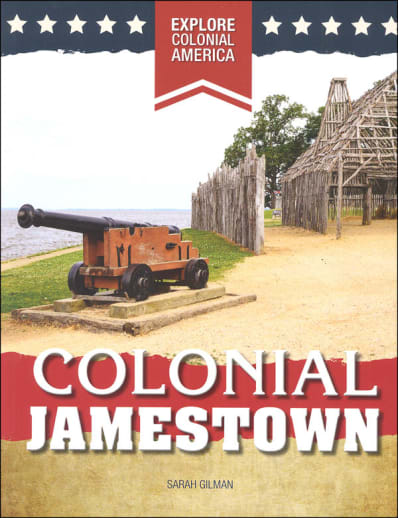Readers of this exciting volume will be transported back to Colonial Jamestown, the first permanent English colony in North America. Through simple text and full-color images, students will experience the journey along with the colonists: the difficult voyage overseas, illness and starvation, uncertainty about the local American Indians, and the hard work that went into forming a successful colony.
Colonial Jamestown (Explore Colonial America)
SKU
051765
ISBN
9780766078772
Grade 4-8
These icons are designed to help you quickly understand and learn important information about our products.
Teaching Method
Traditional
Teacher-centered curriculum commonly used in classrooms that may include a text, teacher manual, tests, etc.
Charlotte Mason
A methodology based on the work of a 19th century educator who maintained that children learn best from literature (Living Books), not textbooks.
Classical
A methodology based on the Latin Trivium (three stages of learning), including the grammar stage (memorization and facts), logic stage (critical thinking), and rhetoric stage (developing/defending ideas).
Unit Study
A thematic or topical approach centered around one topic that integrates multiple subject areas.
Montessori (Discovery)
A methodology based on the work of a 20th century educator that emphasizes student and sensory-driven discovery learning and real-life applications.
Other
Other methodologies
Religious Content
Secular
Contains content contrary to common Christian beliefs (i.e. evolution).
Neutral
Avoids religious or theoretical topics or presents multiple viewpoints without preference.
Christian/Religious
Faith-based or including instructional religious content.
Learning Modality
Auditory
Learns through listening, talking out loud or reading out loud.
Visual
Learns through seeing, prefers written instructions and visual materials.
Kinesthetic/Tactile (Hands-On)
Learns through moving, doing and touching.
Multi-Sensory
Curriculum that employ a variety of activities/components.
Presentation
Sequential
Curriculum progresses through well-defined learning objectives. Emphasizes mastery before moving to the next topic.
Spiral
Topics and concepts are repeated from level to level, adding more depth at each pass and connecting with review.
Conceptual/Topical
Focus is on the “why,” often with a unifying concept as well as specific skills; coverage may be broader.
Teacher Involvement
Low Teacher Involvement
Student-led materials; parent acts as a facilitator.
Medium Teacher Involvement
A mix of teacher-led time and independent student work.
High Teacher Involvement
Teacher-led lessons; may utilize discussions, hands-on activities and working together.
Additional Materials Required
No other materials needed
Everything you need is included.
Other Materials Required
There are additional required resources that are a separate purchase.
Other Materials Optional
There are additional resources mentioned or recommended but are not absolutely necessary.
Consumable
Consumable
Designed to be written in; not reusable.
Non-Consumable
Not designed to be written in; reusable.
Our Price
$12.70 $12.70 $9.50
Rainbow Savings: $3.20
Description
Publisher's Description of Colonial Jamestown (Explore Colonial America)
Category Description for Explore Colonial America Series
Learn key history concepts and themes with these accessible readers. Easily read text (10 pt. font) is adorned with paintings and photos of original documents and maps. Multiple, short chapters allow for focused attention, and I appreciate the text's engaging, yet factual presentation (with no presupposed biases). Choose from focused themes like the Boston Tea Party or Ben Franklin, to overall themes. Includes a written timeline, glossary with definitions, suggested further reading, web links, and an index. Approximately Grade 5 reading level. 7 ¼"x 9 1/4". 48 pgs, hc. ~ Ruth
Details
| Product Format: | Paperback |
|---|---|
| Grades: | 4-8 |
| Brand: | Enslow Publishers |
| Author: | Sarah Gilman |
| ISBN: | 9780766078772 |
| Length in Inches: | 9.5 |
| Width in Inches: | 7.5 |
| Height in Inches: | 0.375 |
| Weight in Pounds: | 0.7 |
Videos
Reviews

